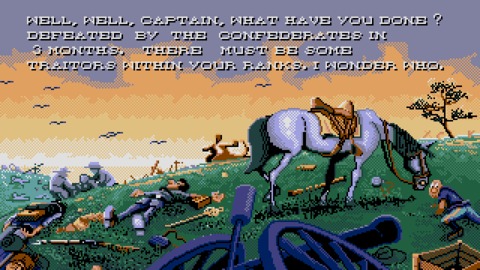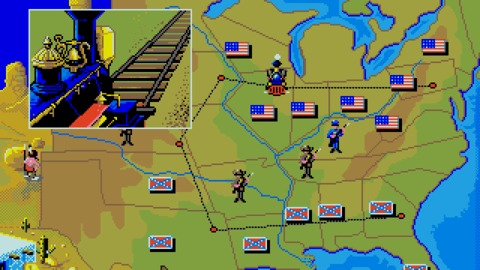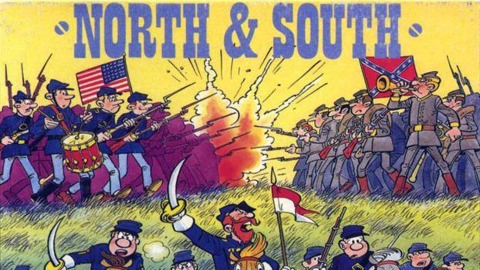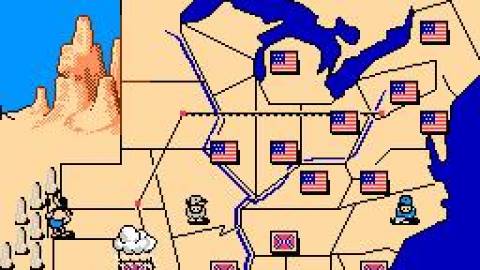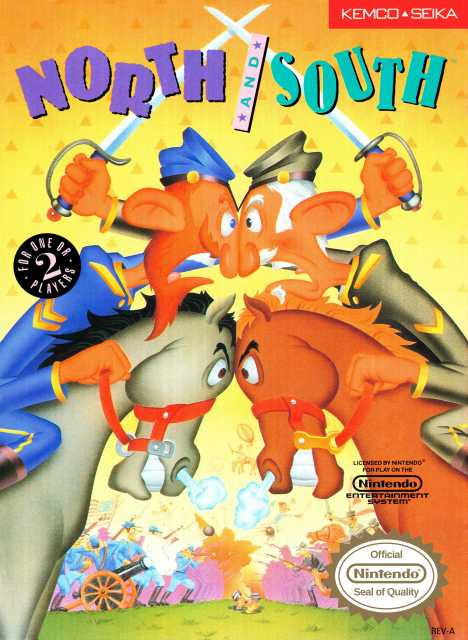Overview
North & South is a 1989 turn-based strategy-sim game about the American Civil War and an offshoot of the Belgian comic Les Tuniques Bleues. It was developed by the French video game company Infogrames (now Atari SA) and released on a number of home computers, as well as the NES.
One or more players picks a side and tries to win the American Civil War. At the beginning of a game of North & South the player can choose the starting year of the game (which determines how the two sides are doing), the AI difficulty of the factions, and whether or not the player wants three simulation options: weather (which can prevent armies from moving), intervention by the British or occasional attacks by the Native Americans and Mexicans.
Gameplay
The gameplay of North & South happens in three phases:
The Strategic Phase
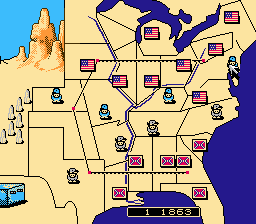
The player begins the game looking at a map of the United States with a handful of starting territories occupied by the Union and a handful by the Confederacy. The player movse their armies across the map to take control of territory and engage the enemy. Although all territory counts towards the player's reinforcements, the most important areas to take are railway stations. The more railway stations a player controls, the more maximum reinforcements they can receive at the end of their turn. A player cannot get reinforcements without having at least two connected railway stations.
The Battle Phase
When two armies engage on the strategic map, a real-time battle ensues where the two forces are arranged on opposite sides of one of several battle maps. A normal army includes the following soldier types:
- Infantrymen: An army begins with a group of six infantrymen. They attack by shooting forward a small distance, but need to get out of formation when moving. This can cause them to be slow to deal with the faster cavalry, but unlike cavalry are able to retreat.
- Cavalry: An army begins with a group of three cavalrymen. They are very fast, but once they start moving towards the opposite side of the map they cannot reverse direction until they reach the opposite side. They attack at close range by swinging their cavalry swords. They have to rely on avoiding the gunfire of the infantry and artillery to get close enough to eliminate them.
- Artillery: An army begins with a single artillery cannon. The artillery cannon can move vertically on the tactical map to avoid getting hit, but it cannot advance. The artillery piece attacks by firing a cannon shot. The player determines how far the shot goes by using a power gauge. The artillery is the only unit in the game with variable shot range and has by far the longest attack range. The artillery automatically retreats from battle if it runs out of ammunition.
The battle ends when one of the forces is annihilated. The maps that the game provides have significant differences, but most of the maps revolve around control of two bridges that bridge a divide between the two armies. These bridges can be damaged by artillery fire. Control of these points leads to victory. Some items on the map, such as houses and often bridges can be damaged or destroyed by artillery fire. Combining two armies on the strategic map results in a single army able to enter this phase with twice as many troops.
The Attack Phase
There are two ways to conquer an enemy railway station in North & South. The first way is to conquer all of the surrounding territories, in which case the railway area automatically switches control to the conquering player. The other way is a head-on attack with an infiltrator. When a player attacks a railway station with one of their armies, the attack phase begins.
In the attack phase, the attacking player controls a single man from a two-dimensional side-scrolling perspective. He must run across a fort area guarded by explosives, attack dogs and soldiers from the opposing player before the time limit runs out. The attacking invader can be hit unlimited times, but every time he is hit, he is momentarily stunned, losing time. The opposing player loses a man every time he is hit by the attacking player and will not be able to respawn his avatar if he is defeated a set number of times during the sequence. The invader starts the sequence with a handful of throwing knives, which he can use to attack the defending player's soldiers. The defending player also has knives, but they respawn every time their soldiers respawn. If the invader reaches the end of the fort, the railway station becomes theirs on the strategic map.
There is also a very similar sequence that begins if one of a player's armies intercepts one of the enemy's trains during their travel. In that case the player must move their avatar across a moving train while the defending player is trying to knock them off it.

 Amiga
Amiga PC
PC

